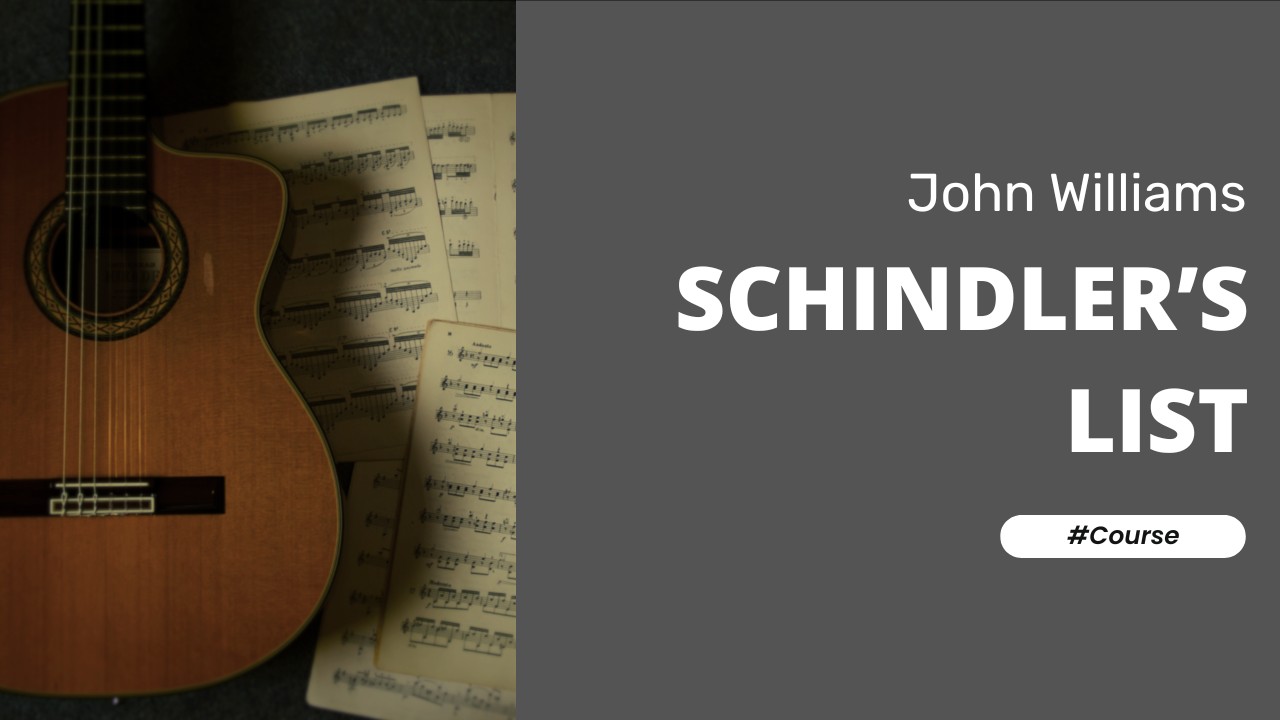Spanish Romance by Anonymous
Introduction to Spanish Romance Guitar Course
“Spanish Romance (Romanza, Romance de Amor, Romance Anónimo)” is without a doubt one of the most iconic pieces in the classical guitar repertoire. Its history has been speckled with conjecture as to who actually wrote that piece. At various times it has been attributed to Antonio Rubira, David del Castillo,[1] Francisco Tárrega, Fernando Sor, Daniel Fortea, Miguel Llobet, Antonio Cano, Vicente Gómez and Narciso Yepes! (sourced from Wikipedia). I think it’s easier just for it to remain anonymous!
Tips
From a compositional point of view the piece is in Binary form starting out in E-minor and then modulate to the tonic major. My first guitar teacher taught me a couple of variations which I have included in this transcription. The first is a slightly different series of bass notes at the end of the A section.The second is a coda that incorporates a series of artificial harmonics played over a F# minor chord followed by an E major chord. Finally culminating in three artificial harmonics on the first string pitched at one octave, then a compound 5th, then two octaves.
Technically speaking the piece is not too difficult yet is a beautifully written piece with an unforgettable melody. A single pattern in the picking hand is used throughout the piece, and with the exception of a couple of difficult stretches in the B section, the piece is not overly challenging for the left hand either.
The biggest single mistake I hear beginners make is forfeiting the last couple of notes in the arpeggio so that they can get to the next chord on time. Please do your utmost to avoid this tragedy! Finish every single note before moving to the next chord. This is why planning ahead and using the correct fingerings is essential when playing the guitar in any style.
Musical Style
Francisco Tárrega’s musical style is characterised by its blend of Romantic expressiveness and Spanish folk influences. His compositions often feature lyrical melodies, rich harmonies, and intricate fingerstyle techniques, showcasing both technical prowess and emotional depth. Tárrega’s works frequently include arpeggios, tremolos, and dynamic contrasts, emphasising the guitar’s capabilities as a solo instrument. His pieces reflect a deep understanding of the guitar’s expressive potential, making them essential studies for both technique and musicality. Tárrega’s influence on the classical guitar repertoire is profound, as he established foundational techniques and expanded the instrument’s possibilities, inspiring generations of guitarists.
Notable Pieces
Five notable pieces by Francisco Tárrega:
• Adelita
• Capricho Árabe
• Gran Vals
• Lágrima
• Recuerdos de la Alhambra
All of these pieces are available as standalone courses or as part of the ‘Travel with Tárrega’ collection exclusive to NBN Guitar.
Let your fingers fly!
Josh
Course Instructor
Spanish Romance Course
About this Course
Introduction to Spanish Romance Guitar Course
“Spanish Romance (Romanza, Romance de Amor, Romance Anónimo)” is without a doubt one of the most iconic pieces in the classical guitar repertoire. Its history has been speckled with conjecture as to who actually wrote that piece. At various times it has been attributed to Antonio Rubira, David del Castillo,[1] Francisco Tárrega, Fernando Sor, Daniel Fortea, Miguel Llobet, Antonio Cano, Vicente Gómez and Narciso Yepes! (sourced from Wikipedia). I think it’s easier just for it to remain anonymous!
Tips
From a compositional point of view the piece is in Binary form starting out in E-minor and then modulate to the tonic major. My first guitar teacher taught me a couple of variations which I have included in this transcription. The first is a slightly different series of bass notes at the end of the A section.The second is a coda that incorporates a series of artificial harmonics played over a F# minor chord followed by an E major chord. Finally culminating in three artificial harmonics on the first string pitched at one octave, then a compound 5th, then two octaves.
Technically speaking the piece is not too difficult yet is a beautifully written piece with an unforgettable melody. A single pattern in the picking hand is used throughout the piece, and with the exception of a couple of difficult stretches in the B section, the piece is not overly challenging for the left hand either.
The biggest single mistake I hear beginners make is forfeiting the last couple of notes in the arpeggio so that they can get to the next chord on time. Please do your utmost to avoid this tragedy! Finish every single note before moving to the next chord. This is why planning ahead and using the correct fingerings is essential when playing the guitar in any style.
Musical Style
Francisco Tárrega’s musical style is characterised by its blend of Romantic expressiveness and Spanish folk influences. His compositions often feature lyrical melodies, rich harmonies, and intricate fingerstyle techniques, showcasing both technical prowess and emotional depth. Tárrega’s works frequently include arpeggios, tremolos, and dynamic contrasts, emphasising the guitar’s capabilities as a solo instrument. His pieces reflect a deep understanding of the guitar’s expressive potential, making them essential studies for both technique and musicality. Tárrega’s influence on the classical guitar repertoire is profound, as he established foundational techniques and expanded the instrument’s possibilities, inspiring generations of guitarists.
Notable Pieces
Five notable pieces by Francisco Tárrega:
• Adelita
• Capricho Árabe
• Gran Vals
• Lágrima
• Recuerdos de la Alhambra
All of these pieces are available as standalone courses or as part of the ‘Travel with Tárrega’ collection exclusive to NBN Guitar.
Let your fingers fly!
Josh
Course Instructor
Spanish Romance Course




